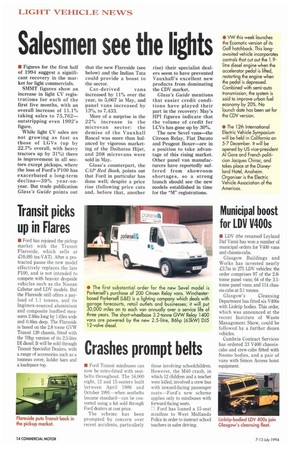Salesmen see the lights
Page 16

If you've noticed an error in this article please click here to report it so we can fix it.
• Figures for the first half of 1994 suggest a significant recovery in the market for light commercials.
SMMT figures show an increase in light CV registrations for each of the first five months, with an overall increase of 11.1% taking sales to 75,762— outstripping even 1992's figure.
While light CV sales are not growing as fast as those of LGVs (up by 22.7% overall, with heavy tractors up by 31%) there is improvement in all sectors except pickups, where the loss of Ford's P100 has exacerbated a long-term decline-39% year-onyear. But trade publication Glass's Guide points out that the new Flareside (see below) and the Indian Tata could provide a boost to the sector.
Car-derived vans increased by 11% over the year, to 5,067 in May, and panel vans increased by 13%, to 7,433.
More of a surprise is the 22% increase in the microvan sector: the demise of the Vauxhall Rascal was more than balanced by vigorous marketing of the Daihatsu Hijet, and 208 microvans were sold in May.
Glass's counterpart, the CAP Red Book, points out that Ford in particular has done well; despite a price rise (following price cuts and, before that, another rise) their specialist dealers seem to have prevented Vauxhall's excellent new products from dominating the CDV market.
Glass's Guide mentions that easier credit conditions have played their part in the recovery: May's HPI figures indicate that the volume of credit for LCVs has gone up by 30%.
The new Sevel vans—the Citroen Relay, Fiat Ducato and Peugeot Boxer—are in a position to take advantage of this rising market. Other panel van manufacturers have reportedly suffered from showroom shortages, so a strong launch should see the new models established in time for the "M" registrations.
































































































